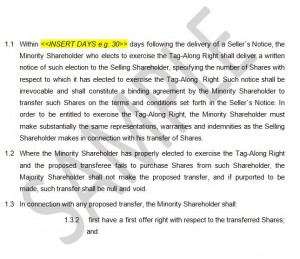In this blog post, Kriti Kakkar, Student of Lucknow University and Diploma in Entrepreneurship Administration and Business Laws by NUJS lists the different ways to word a tag along clause.
Different Ways To Word A Tag Along Clause
In a startup or another business endeavor including more than one person who contributes monetarily or something else, pays to guarantee that their commitment is recognized in a protected and responsible way. “Shareholder’s Agreement” (SHA) is restricted in which such security can be recompensed to all partners.
The meaning of Shareholder’s Agreement is a coup contract between the shareholders of an enterprise, characterizing the shareholders’ rights, benefits, insurances, and commitments. The shareholder’s agreement, as a rule, incorporates the company’s articles of joining and ordinances.
The shareholder agreement gives a sort of proprietorship that an accomplice putting resources into a business might appreciate it as it has the crucial rights. The understandings accommodate matters, for example, confinements on exchange of shares (right of first refusal, right of first offer), constrained exchanges of shares (tag-along rights, drag-along rights), designation of executives for representation on sheets, majority necessities and veto or majority rights accessible to specific shareholders at board level or shareholder level.
A shareholder agreement can, however, put confinements on the exchange of shares from one gathering to the outsider. This is done to counteract subjective or exploitative exchange of shares. A ‘exchange limitation’ confines shareholders from moving their shares in the organization.
What does a Shareholder’s Agreement regularly include:
- Nomination of Directors – The agreement might designate the rights to specific partners to be on board and additionally choose the composition of the Board.
- Roles and commitments of every shareholder.
- Financing prerequisites, majority necessities and veto rights.
- Representation and Warranties from the Company.
- Restrictions on the exchange of shares (right of first refusal, the right of the first offer).
- Forced exchange of shares (tag-along rights, drag-along rights) and abridging of further issue of shares.
- Defining Shareholding Threshold: There can be a minimum shareholding under the agreement. A party must have to enjoy the rights as under the Shareholding Agreement.
- Determining and designating unique rights to the certain shareholder.
What do Shareholder Agreements do?
Shareholder Agreements is a way for the founding members to regulate or even restrict the amount of shares allotted to the shareholders. The courts usually do not accept the company legislation unless the legislation is incorporated in the articles of association, yet they offer a way in which owners of a company can invite and incentivize talent – all the while regulating the flow of actual stake.
The clauses in this regard often found in a Shareholders’ Agreement to regulate the transfer of shares are:
- Right of First Refusal: The right of first refusal is a contractual right; the entity is given an opportunity to enter into business with any partner he wants. The entity is given such an opportunity and also has the right to refuse, this opportunity however usually has an asset. When and if the entity of the first right refuses the opportunity the owner of the asset is free to bid his business with someone else.

- Right of First Offer:This clause enables a preferential option to certain stakeholders in which the prices of the shares are fixed beforehand. The holder of the right to first offer must be given a bid to buy the shares from the respective shareholder who wants to sell. If the holder of the right of the first offer refuses then, the shareholder is free to sell his shares to anyone.
- Drag-along Rights: A drag along right allows a shareholder of a company (Usually a majority shareholder or institutional investor) to force the remaining shareholders to accept an offer from the third-party to purchase the whole company, where the majority shareholders have accepted that offer, on the same terms. The other (usually minority) shareholders are then ‘dragged along’ and forced to sell their shares at the same time and the same price for each share.
- Tag-along Rights: On the lines of Drag-on rights, tag along is a provision which allows the minority stakeholders to participate in the sale of the shares along with the majority shareholders for a good price at the same time. The minority stakeholders then tag along with the majority stakeholders.
- Buy-back Rights: This gives the company a chance to buy back shareholders unvested shares at a lower price of a fair market value. The situation under which the shares are bought varies and can be through resignation or death etc.
- Call Option: This option gives the holder a right to buy the shares at an already determined rate also known as ‘strike price’ between the date of purchase and the options expiration date.

- Put Option: As the name suggests it allows a shareholder to share his shares at an already decided price also known as the ‘strike price.’
- Anti-Dilution: An anti-dilution provision is a provision in an option or a convertible security. It protects an investor from dilution resulting from later issues of stock at a lower price than the investor originally paid. Also known as an “anti-dilution clause.
- Pre-emptive: Under the pre-emptive right, the Company brings to the table any future shares that might be issued, first to the Shareholder (on a professional rate premise) before offering it to some other gathering, and additionally permit the shareholder to look after his/her shareholding design.
Can A Shareholders’ Agreement Bind a Third Party?
Privately owned companies are similar to affectionate families. They have a tendency to appreciate the confirmation and solace to control what they do; be it the connection between the partners or fashioning ties with outsiders. Ordinarily, under the present Indian Law, it ties the two gatherings under it. With a specific end goal to make it binding to a third-party company regulated matters must form part of public domain – i.e., it must reflect in company bylaws (visible to public). This gives reasonable notice to others.
 Serato DJ Crack 2025Serato DJ PRO Crack
Serato DJ Crack 2025Serato DJ PRO Crack










 Allow notifications
Allow notifications



